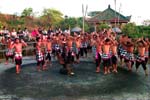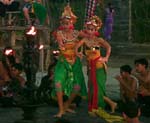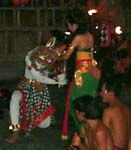Barong Dance.
Barong is probably the most well known dance. It is also another story telling dance, narrating the fight between good and evil. This dance is the classic example of Balinese way of acting out mythology, resulting in myth and history being blended into one reality.
The story goes that Rangda, the mother of Erlangga, the King of Bali in the tenth century, was condemned by Erlangga's father because she practiced black magic. After she became a widow, she summoned all the evil spirits in the jungle, the leaks and the demons, to come after Erlangga. A fight occurred, but she and her black magic troops were too strong that Erlangga had to ask for the help of Barong. Barong came with Erlangga's soldiers, and fight ensued. Rangda casted a spell that made Erlangga soldiers all wanted to kill themselves, pointing their poisoned keris into their own stomachs and chests. Barong casted a spell that turned their body resistant to the sharp keris. At the end, Barong won, and Rangda ran away.
Somebody can die or get seriously injured in a Barong dance. It is said that if Rangda's spell is too strong, a weak soldier may not be able to resist it, even with the help of Barong. He may end up hurting himself with his own keris.
The masks of Barong and Rangda are considered sacred items, and before they are brought out, a priest must be present to offer blessings by sprinkling them with holy water taken from Mount Agung, and offerrings must be presented.
The Kecak Dance
 The choir for the Kecak dance make their entrance. |
On Bali, dancing is still a regular part of Balinese life. Most Balinese dancing is closely related to the classical dancing of other Southeast Asian cultures. There are many similarities between the classical khon dances of Thailand and the Balinese Barong and Legong dances. These are all similar to western ballet, in that they tell a story.
But an absolute "must see" for visitors to Bali is the Kecak dance performance. This is the most unique form of Balinese dance, so be sure to reserve an evening for it. You've probably seen pictures of this dance. Rather than the Gamelan orchestra that is typical of other Balinese dances, as well as most Southeast Asian classical dancing, in the Kecak the only music is provided by a large chorus of bare-chested men and boys sitting in a circle just in front of the audience. This choir provides a constant accompaniment to the story, and even become actors towards the end.
 Beyond the circle of the dance, the sun sets into the sea next to the temple. |
We saw the Kecak in the wonderful setting of the Uluwatu temple near the Southern tip of Bali. The temple is set dramatically high on a cliff that drops straight into the blue sea below. The temple has a large population of greedy monkeys, so watch out for anything that can be easily grabbed. The performance is held on an open-air stage just beyond the temple with the sun setting into the sea in the background.
 Sita and escort enter the scene. |
The story is simple, and its not really necessary for you to know it to appreciate the dance. The dance depicts a sub-plot from the Hindu epic the Ramayana. In the story the wife of Rama, Sita, is kidnapped by Rama's arch-enemy, the king of Lanka, and taken to his palace of Alengka.
In his search for Sita, Rama enlists the aid of the red monkey king Sugriwa. Together they select Hanoman, a white monkey with magical powers, to find Alengka and seek out Sita. Rama gives Hanoman his ring so that he can prove his identity to Sita when he finds her.
 Hanuman shows Sita Rama's ring. |
Hanoman finds Sita, gives her the ring, and attempts to destroy the palace where Sita is held, but is caught. In perhaps one of the performance's most dramatic scenes, Hanuman is bound and placed in a ring of straw that is set on fire. The sun has set by this time, so we see the white and gold monkey dance back and forth over the burning straw, eventually kicking the sparks up into the air as he chases off his persecutors. The great general returns with his army of monkey warriors, portrayed by the choir. The bad guys are defeated. Sita is reunited with Rama. The end.
The Kecak is so popular among tourists that you can find performances almost anywhere on Bali. The best place, in our opinion, is the cliff-top temple of Ulu Watu.
The Welcome Dance - Tari PanyembramaThe Panyembrama is probably the most popular Balinese social dance. In keeping with its meaning in the Balinese Language, Panymebrama is frequently staged to welcome guests of honour who are making a visit to this islands of the Gods.
Four or eight young girls bearing a bokor, a heavily engraved bowl made from silver or aluminium, laden with flowers, dance expressively to the accompaniment of vibrant gamelan music.
During the dance, the flowers are scattered over the guest or audience as an expression of welcome. The Panymebrama has taken many of its movements from temple dances, such as the Rejang Dance, Pendet and Gabor, which are considered sacred and performed exclusively for God. There is an analogy between the secular Panymebrama and the religious temple dances, as all these dances are welcoming dances, the difference being in the place in which they are stage.
The Tari Panymebrama comes under the Balinese classification of Legong (individual dances), because it has no connection with other dances, has no story and was specifically created for welcoming and entertainment purposes.
The hospitality and friendliness conveyed through the smiles of the Panymebrama girls, charms the audience and so is very fitting as an opening for a show, etc.
The Yudapati Dance
Yudapati is a dance which depicts a male character but is performed by female dancers. The word Yudapati is derived from Yuda which means war and Pati which means death. The dance represents the kamikaze warrior in defending the truth. The dance was created in 1987. It is based on the Baris dance.
The dancer wears typical male attire, headcloth, shirt, carved leather belt and other jewellery. The reason for a male being performed by a female is that the choreographer wishes to reveal all the subtle gestures and movements in the dance by using the flexibility of a woman's body.
Male dance performed by females is called Bebancihan. A number of other dances have been created in the s style, such as Margapati, Trunajaya, Prawireng Puti, Wiranata and Danur Dara. They require masculine interpretation and expression which is quite hard for female dancers. Yudapati dance was originally performed for religious purposes but nowadays is performed regularly as a tourist attraction in some restaurants.
The Ghopala Dance
This dance provides the audience with an interesting insight into the lives of people who live in a simple and pure manner in an environment of blissful tranquillity. This dance originated in 1984 and usually performed by five boy dancers. The characters of the Ghopala dance are especially funny and will draw laughter from the audience.
The Ghopala theme depicts the world of children herdsmen who gleefully meet and play along the boundaries of rice fields while tending their cows. Their lives are filled with happiness as they dance and play in a way which highlights their individual characters. They never tire of their duties as herdsmen, faithfully defending the lives of their cattle. Thus the audience are transported to a distant time when people lived in peace and contentment, an age which had not yet become influenced by the bustle of business which now constantly steals our time.
The Semarayana Dance
As we know, there exists many art forms such as music, painting, poetry, drama, sculpture, etc. and, of course, dancing is yet another and is a popular form of expression. Artists will take a certain aspect of a medium, build on it to form another. This is the case of the Semarayana dance developed in 1994 as a subject for a thesis submitted by Ms Ni Nyoman Sri Armita to the Indonesian Arts Academy of Denpasar for her graduation.
The main character is Dewi Chandra Kirana, a princess from the kingdom of Daha who disguised herself as a male youth so she could venture out and seek her beloved who had disappeared without a trace.
With shoulder length hair, commonly used centuries ago throughout Java and Bali, the princess was unrecognisable as a female. The symbol of manhood which fooled people she met on the road, was the use of the Balinese male headgear called the Destar. It is made from material that wraps around the head and has an artistic formation of bunched material at the front.
Balinese males still use the destar when attending ceremonies. The feature of the destar is the decorative use of gold lines.
Dewi meets her beloved but due to her disguise and the fact that he is partly obscured when they meet, a fight develops. In the ensuing melee, the princess's destar is knocked from her head and her sweetheart, Raden Inu Kertapati, recognises her and rushes to her side to embrace her.
And, of course, they lived happily ever after.
The Sanghyang Jaran Dance
The unique feature of the Sanghyang Jaran dance is the courage of the dancers who in a state of Kesurupan or trance, calmly step and trample on red hot coals just as if they were walking in cold water.
This dance is believed to have the power to invite the gods or sacred spirits to enter the body of the dancers and put them in a state of trance. It dates back to the ancient Pre-Hindu culture, a time when the Balinese people strongly believed that a dance could eliminate sickness and disease. The is dance is usually performed in the fifth or sixth month of the Balinese traditional calendar as it is believe that during these particular months, the Balinese are vulnerable to all kinds of illnesses.
The War Dance - Gebug Ende
The Gebug Ende is a combination of dance and trial of prowess. It is usually performed by two to sixty male dancers who dance and fight on stage in pairs. Each dancer/fighter carries a one and a half metre long rattan stick as as a weapon and a shield called an ende. During the performance the two men try to beat one another with the stick while using the ende to protect themselves. The dance is called Gebug Ende as it literally means beating the ende or shield. One cannot afford to make mistakes in this dance as otherwise injury results.
The Gebug Ende is quite unique as it has certain rules that have to be followed by the participants. Led by a jury, this dance starts with two dancers, while the rest sit in a circle, cracking jokes and singing, while waiting their turn. The jury decide which of the two contestants loses the game and has to leave the stage. Then they will call the next men to the stage. This continues until all have had a turn. Sometimes the fight becomes very fierce and the dancers get thrown of the stage from the blows of the rattan stick. Bruises and wounds are common in this ritual.
Legong Trunajaya - The dance of love and emotions
The Trunajaya dance describes the emotions of a young man through love and passion. The dance movements reflect the theme of courtship and love.
Truna meaning 'single' and jaya meaning 'to win' immediately gives an understanding of the dance. Ironically, the dancer are young women who take on the role of young men. The women wear a 'destar' normally worn by men and an unusual loin-cloth called a 'kancut'. The Trunajaya is normally danced by a single female but sometimes two, dancing together in synchronous movements and to the mesmorotic sounds of the 'Gong Kebyar', a fast, rhythmic beat which goes in harmony to the dance. The dance was created by Wayan Wandres, from Singaraja, Northern Bali.



1 comment:
Hai,pik's siip blogger nya, tapi tolong yach ada terjemahan bahasa indonesia nya biar orang yang nggak ngerti bahasa inggris bisa paham, dari yafisa
Post a Comment